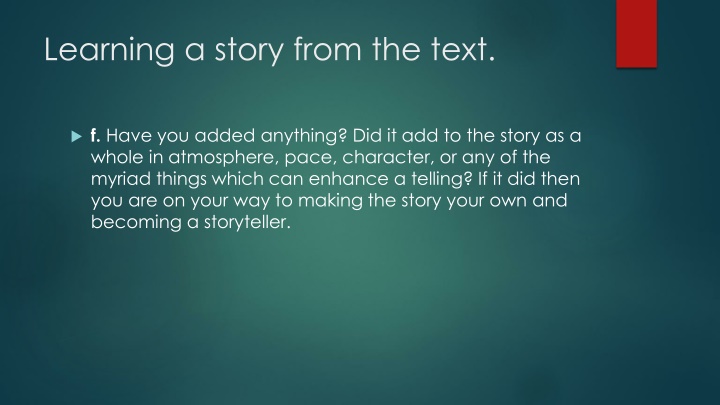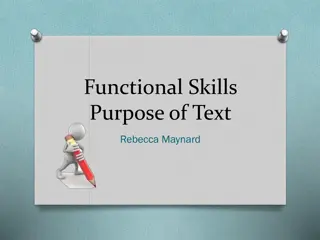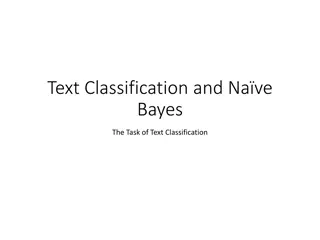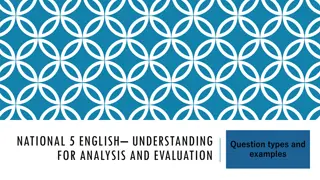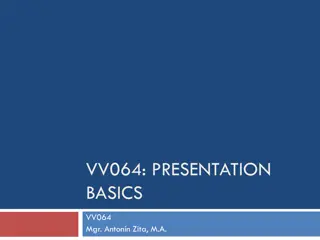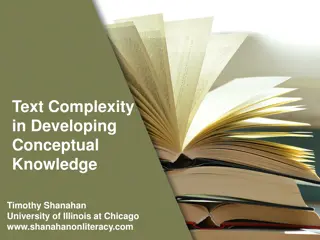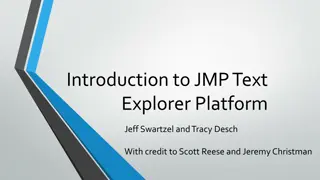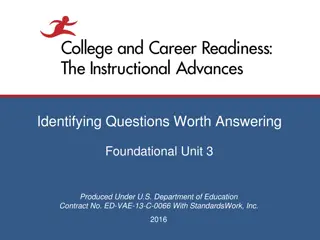Learning a story from the text.
Crafting a unique narrative involves adding personal elements to a given text. By infusing your perspective into the story, you can elevate its essence in terms of atmosphere, pace, character development, and other storytelling elements. This process not only enriches the storytelling experience but also paves the way for you to become a proficient storyteller capable of captivating audiences with your creative flair.
Download Presentation

Please find below an Image/Link to download the presentation.
The content on the website is provided AS IS for your information and personal use only. It may not be sold, licensed, or shared on other websites without obtaining consent from the author.If you encounter any issues during the download, it is possible that the publisher has removed the file from their server.
You are allowed to download the files provided on this website for personal or commercial use, subject to the condition that they are used lawfully. All files are the property of their respective owners.
The content on the website is provided AS IS for your information and personal use only. It may not be sold, licensed, or shared on other websites without obtaining consent from the author.
E N D
Presentation Transcript
Learning a story from the text. f. Have you added anything? Did it add to the story as a whole in atmosphere, pace, character, or any of the myriad things which can enhance a telling? If it did then you are on your way to making the story your own and becoming a storyteller.
Are they going for a picnic? Does baby go back for the tin- opener? Have they got the tin-opener? After six years are they hungry? Are they tortoises or snakes? Are they carrying baskets or bags? Are they going for a picnic or a walk? Are they hungry or thirsty? Who are the characters? What are they carrying in their baskets? Where are they going? What have they forgotten?
Once upon a time there were three frogs, a mother, a father and a grandfather. One beautiful winter day they decided to go for a walk
Learning a story from the text. g. Having looked at the book put it away and tell the story again. Get the taste of the tale on your tongue. (repeat the reading and telling as necessary) h. Eventually you will not be looking back at the text in order to improve your telling
Visualising a story. It is often easier to put a story into your own words if you learn this way. However you won t be able to do this till the story is fixed firmly in your mind.
Visualising a story. a. Having read your story, a number of times to fix it in your mind, take a piece of paper and a pencil. Think about what happens in the story and draw a series of pictures of the action. These can either be in the form of a series of storyboards or a more flowing, map like interpretation. Don t worry about the quality of the artwork; it is just a form of visual notes. You should try to reduce the story to a series of key images, no more than ten.
Visualising a story. b. Find somewhere comfortable and retell the story, visualising what happens as you go, see how each scene follows the next like a silent movie. c. Having retold the story look back at your storyboards and if necessary the text of the story. Ask the same questions you would if learning by the text method.
Visualising a story. d. Once you have the action firmly fixed in your head start visualising the details. Don t bother to draw anything, just close your eyes and look at the people in the story and the places where they are. See them so clearly that if someone were to ask you a question about them you could answer as though you had been there and seen it with your own eyes.
Learning a story by the key facts a. Read the story through once or twice. b. Write the story down in your own words, keep it as brief as possible. c. Tell the story out loud, somewhere you feel comfortable.
Learning a story by the key facts d. Write the important things to remember as a series of keywords. For example to remember the story of the Gingerbread Boy you might list. Gingerbread Boy, Runs, Old couple, Rhyme(Run, Run, as fast as you can. You can t catch me, I m the Gingerbread Man.), Cat, Dog, Pig, Goat, Cow, Horse, Fox, River, Swim, Back, Shoulder, Head, Nose, Mouth. Keep the list short, and record as little detail as possible.
Learning a story by the key facts e. Tell the story again, see what you have left out or added in as described earlier.
Learning a story Aurally a. Read the story into a tape recorder. Some tellers find it best not to read with great expression, just recording the story and adding the expression when they tell it later.
Learning a story Aurally b. Having listened to the tape a number of times practice telling the story.
Learning a story Aurally c. Alternate listening and retelling till you can remember the whole story, as detailed in the learning by text section. d. Do not worry if you make errors or forget elements of the story, you will improve over the retellings.
Learning a story Aurally When you have learned the plot of the story think about the protagonists. Why do they behave in the way they do? Think about their backgrounds and motives, if it isn t in the text then make it up. What emotions are they experiencing? Try telling the story to yourself from different points of view before returning to your original version.
Learning a story Aurally Once you know your story sufficiently well to tell it fluently, tell it to a friend who is willing to ask you questions about it. If you can answer all their questions confidently you know the story well enough to tell it to a wider audience.
Learning a story Aurally Storytelling is an art of both interpretation and improvisation. You tell a story in your own language for the listeners who are immediately in front of you. You can tell the same story to 500 adults in a theatre, 35 seven year olds in a classroom or to a friend down the telephone In each case the story is the same, but, by necessity, the language, tempo and energies involved will be different. A storyteller is simultaneously the interpreter, adapter, author, performer, director and critic of his or her material. Ben Haggarty
Telling Your Story Once you have learned your story you will want to share it. You think it is a good story for your audience, and for yourself.
Telling Your Story 1. Remember you are telling a story; you are not performing a part you have learned for a play. Memorising a story to tell like that is recitation not storytelling. Relax and let the story tell itself through you, that way it will be fresh and spontaneous.
Telling Your Story 2. Wherever you are telling your story you should first check your audience is ready. Look round to ensure everyone is settled before you begin.
Telling Your Story 3. Start clearly. You might use a traditional beginning to enable people to key into your voice. Once upon a time or Far away and long ago are both traditional English beginnings, find one that matches your story.
Telling Your Story 4. While you are telling make brief eye contact with members of your audience. 5. Enhance the story by varying the rhythm and tone of your voice. Taste the words as they pass over your lips.
Telling Your Story 6. Hold the story in your mind s eye as you tell it. Be aware of where things are in the story in relation to yourself. 7. End the story strongly. There are as many traditional endings as there are beginnings: They lived happily, so may we. Put on the kettle, lets have a cup of tea. Or you could make up your own.
If you have internet access you can find a variety of traditional beginnings and endings on some of the storytelling websites.
